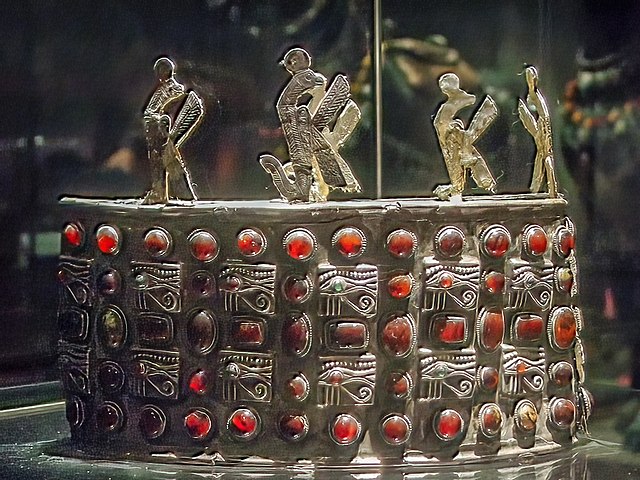Nobatia or Nobadia was a late antique kingdom in Lower Nubia. Together with the two other Nubian kingdoms, Makuria and Alodia, it succeeded the kingdom of Kush. After its establishment in around 400, Nobadia gradually expanded by defeating the Blemmyes in the north and incorporating the territory between the second and third Nile cataract in the south. In 543, it converted to Coptic Christianity. It would then be annexed by Makuria, under unknown circumstances, during the 7th century.
Wooden casket with ivory inlays, Jebel Adda (4th century)
Royal crown discovered in Ballana (5th century)
Reliefs of the "Ethiopian" chamber inside the Isis temple of Philae, depicting pilgrims and priests from the south. The inscription in front of the third figure from the left is a letter describing the gifts of a diplomatic mission sent by King Talakhidamani of Kush.
Copy of a Coptic inscription in the Temple of Dendur, commemorating the conversion of the temple into a church during the reign of king Eirpanome (mid-6th century)
Old Nubian is an extinct Nubian language, attested in writing from the 8th to the 15th century AD. It is ancestral to modern-day Nobiin and closely related to Dongolawi and Kenzi. It was used throughout the kingdom of Makuria, including the eparchy of Nobatia. The language is preserved in more than a hundred pages of documents and inscriptions, both of a religious nature, and related to the state and private life, written using adaptation of the Coptic alphabet.
A page from an Old Nubian translation of the Investiture of the Archangel Michael, from the 9th–10th century, found at Qasr Ibrim, now at the British Museum. Michael's name appears in red with a characteristic epenthetic -ⲓ.
Parchment page of the Bible, part of the New Testament (Corinthians and Hebrews) in written in Old Nubian. 9th–10th century CE. From Qasr Ibrahim, Egypt. British Museum.






